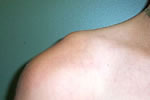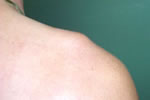| How It Happens |
The clavicle (collar bone) and the acromion process of the shoulder blade join together to form the Acromioclavicular (AC) Joint.
The AC joint is held together with the support of two ligaments: acromioclavicular, coracoclavicular.
|

A/C Joint Subluxation
Anterior View

A/C Joint Subluxation
Posterior View |
| |
|
| Symptoms |
Pain:
Pain is localized over the top of the tip of the shoulder.
Pain is usually made worse with all shoulder movements and may be made worse with deep breathing.
Inflammation:
Inflammation and bruising will be present at the site of injury.
It is the result of torn ligament fibers.
X-Rays:
Depending on the extent of the injury, the x-ray may show a separation or step deformity of the AC joint. |
| |
|
| What Causes It? |
An injury to the AC joint is most often a result of a blow or fall taken on the point of the shoulder.
Falling on an outstretched hand also commonly injures the AC joint.
There are three degrees of AC joint injury:
1st Degree (Sprain)
incomplete tear of the acromioclavicular ligament
no obvious deformity present
2nd Degree (Subluxation)
complete tear of the acromioclavicular ligament and partial tear of the coracoclavicular ligaments
minor step deformity present
3rd Degree (Dislocation)
complete tear of the acromioclavicular and coracoclavicular ligaments
obvious step deformity present |
| |
|
| Why Does It Hurt? |
There is either too much flexibility or too much rigidity in the foot. Both conditions result in localized inflammation at the heel that is "squeezed out" with weight bearing.
At night or rest, inflammation in absorbed into the area, pushing on sensitive nerve endings. The first morning steps are very painful and stiff until the inflammation is squeezed out and scar tissue is stretched. Once the inflammation and scarring are present they are difficult to remove. The longer the condition runs its course without intervention, the more difficult it is to rehabilitate. |
| |
|
| What Should You Do? |
- Rest from painful activities
- Icing will help decrease the inflammation and the pain
- Anti-inflammatory medications prescribed by the doctor
- Sling to be used with 2nd and 3rd degree AC joint injuries
|
| |
| Will Physiotherapy Help Me? |
A physiotherapist will assess your condition and determine the origin of your pain. Your treatment plan will address the local symptoms such as pain and inflammation and work to regain strength and function in the shoulder. With the help of modalities, physiotherapy will reduce your symptoms and promote healing.
To learn more about how you can access and benefit from our services, please contact us today!
|

